This sample Repeat Victimization Research Paper is published for educational and informational purposes only. If you need help writing your assignment, please use our research paper writing service and buy a paper on any topic at affordable price. Also check our tips on how to write a research paper, see the lists of criminal justice research paper topics, and browse research paper examples.
This research paper hinges on four nonobvious propositions that, we suggest, largely encapsulate the state of the art in this field. They are that:
- Most crime is repeat victimization against the same targets, and variation in crime across time and place is often due largely to repeat victimization.
- One or 2 % of potential targets are the supertargets that experience about half of all crimes.
- Preventing repeat victimization reduces crime when tactics are properly developed and implemented.
- A broader-than-usual conception of near-repeat victimization, referring to crimes linked by their similarity, may prove a useful foundation for integrating theories of crime concentration.
The evidence and argument underpinning these statements is presented in what follows. References and some further reading are listed at the end, but readers are encouraged to browse the Oxford Bibliographies Online (Criminology) entry on repeat victimization which summarizes around 150 key studies. It documents the growth of studies from the 1970s onwards, the extent and nature of repeats and near repeats in many different countries, theoretical developments, the link to repeat offending, measurement issues, time-course and life-course studies, the link to policy and practice, and crime-specific prevention studies. The study of repeat and near-repeat victimization has become a mainstay of criminology, crime science, and police science in the last two decades, and its contribution was recently assessed as a key area of theory underpinning environmental criminology and crime analysis (Wartell 2010; Wartell and Gallagher 2012).
Definitions And Concepts
People, places, products or services, vehicle, household, business, or systems (including virtual networks) are, once victimized, more likely to be victimized again. Further victimization by the same type of crime is most likely, but polyvictimization involving two or more crime types is also far more likely than would be expected by random chance. One has only to think of hate crime for this to be recognized.
A small proportion of targets are so chronically victimized that they become supertargets. One classic study found that 1 % of people experienced 59 % of all personal crime including violence and that 2 % of households experienced 41 % of all household crime. The supertargets are the 1–2 % of persons and households, respectively, and they represented around one in eight of all persons or households who were victimized (Pease 1998).
Key features of repeats are that they tend to occur sooner rather than later (Daigle et al. 2008; Mele 2009) and are more likely to be by the same prolific offenders, with success breeding repeats. The result is a temporarily elevated risk, greater with each subsequent crime. Similar general patterns of the extent and nature of repeats have been identified for most crime types and places where informed studies have been conducted, though Sidebottom’s (2011) study of repeat burglary in Malawi observes that “[t]here is little research on repeat victimization in developing countries” (p. 1).
A growth area for repeat victimization studies has been the area of victim careers or life-course studies (Gabor and Mata 2004; Buzawa et al. 2006; Averdijk 2010). Another is that of near-repeat victimization or near repeats, a term coined by Frank Morgan in a study of burglary in Perth, Western Australia (2001). In this research paper, the terms repeat victimization or repeats are sometimes used as inclusive of near-repeat victimization.
Spatially, it is well established that crime hot spots are often substantially, and sometimes exclusively, repeats and near repeats. A few hard-hit stores, for example, may account for peaks in crime maps, but this can be obscured by kernel density estimation techniques. Hence, repeat research has been lauded for providing more precise predictions and insight into a real crime patterns than some traditional hot-spot studies. And what is now sometimes termed predictive policing draws on the tradition of the revictimization predictor (Farrell 1995). The significant general expansion of repeat victimization research in recent years is illustrated by a recent study of personal repeat victimization, of potentially major importance, which suggests there is a genetic aspect to the phenomenon (Daigle 2010).
The following four sections cover the propositions that began this research paper. They are followed by a short conclusion.
Most Crime Is Repeat Victimization Against The Same Targets, And Variation In Crime Over Time And Space Is Often Due Largely To Repeat Victimization
In the United States, 75 % of personal crimes over the course of a year are repeats according to the National Crime Victimization Survey, as shown in Table 1. In England and Wales, about half of property crime and two-thirds of personal crimes are repeats (see details below). The Canadian Victimization Survey found that 2 % of the population who were repeat victims of violence experienced 60 % of all violence (Perreault et al. 2010, and Table 2 which is based the work of Nazaretian and Merolla 2013). This sounds like a lot – and it is – but these are conservative estimates. There are various methodological reasons for this. The surveys tend to exclude crimes such as child abuse and victimization of young people or nonhuman animals which have even higher repeat rates. Likewise, robberies, burglaries, and other crimes against commercial establishments (not covered in conventional victimization surveys) tend to have higher repeat rates than equivalent crimes against individuals and households. Because surveys take a time window of 6 months or a year, events within the window which are repeats of pre-window events, or which are precursors of post-window events, are repeats masquerading as one-off crimes!
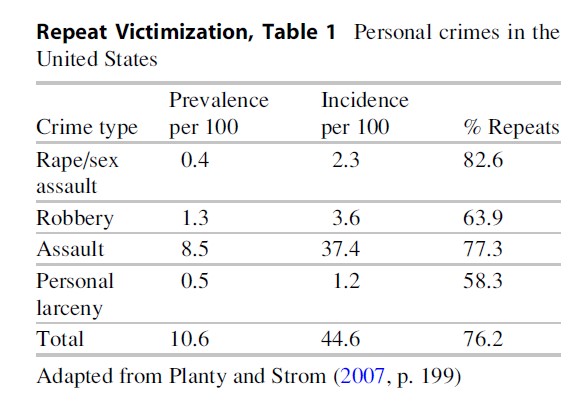
Repeat rates tend to be lower for property crimes than violent crimes, but, as noted above, repeat property crime rates are disproportionately higher in hot spots and high crime areas, so the potential for focused prevention efforts is greater. Overall, however, the evidence suggests that most crimes are experienced by repeat and near-repeatedly victimized persons, places, and other targets.
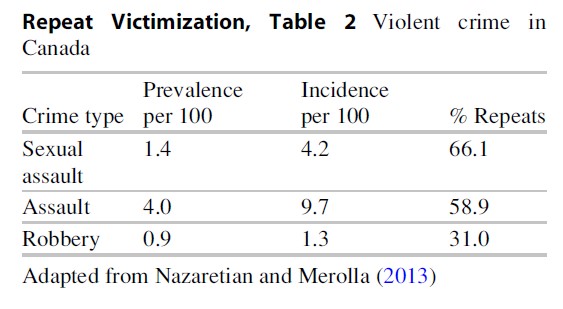
Much of the crime trend in England and Wales since 1980 – both increases and decreases – is linked to change in repeats. This is shown in Fig. 1 for household and property crimes measured by the British Crime Survey and draws on the excellent work of Britton et al. (2012). In the United States, a recent study published by the Bureau of Justice Statistics suggests a similar pattern, with a lot of the crime drop being due to declines in repeat victimization (Lauritsen et al. 2012).

The bulk of variation in violence over time in England and Wales was experienced by repeat violence victims (Fig. 2). Such incidents accounted for half to two-thirds of violence, and 68 % in 1995. Repeats also played a disproportionate role in burglary trends. Repeat victims of burglary experienced around a quarter of burglaries in 1981, rising to 40 % in 1995 (Fig. 3). However, while ostensibly one-off incidents doubled between 1981 and 1995, those at repeatedly victimized households more than trebled (a 330 % increase). Between 1995 and 2010, both singles and repeats fell back to their 1981 level.
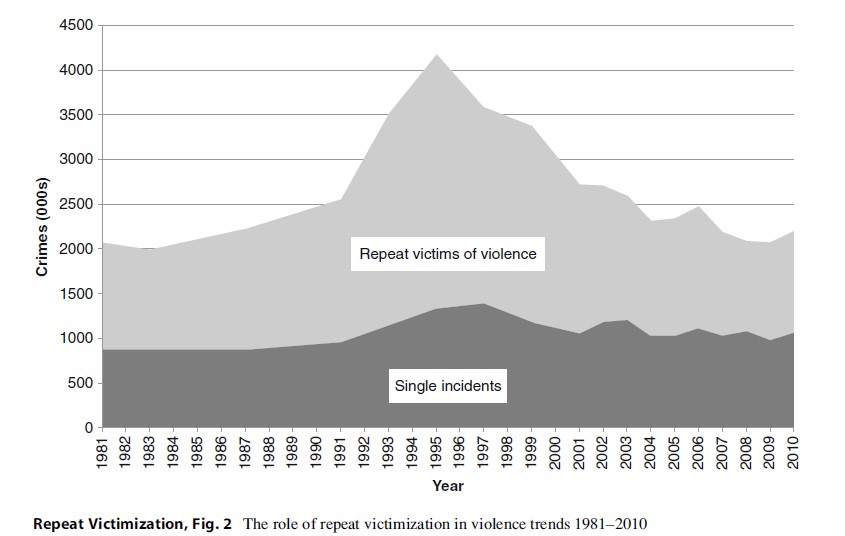
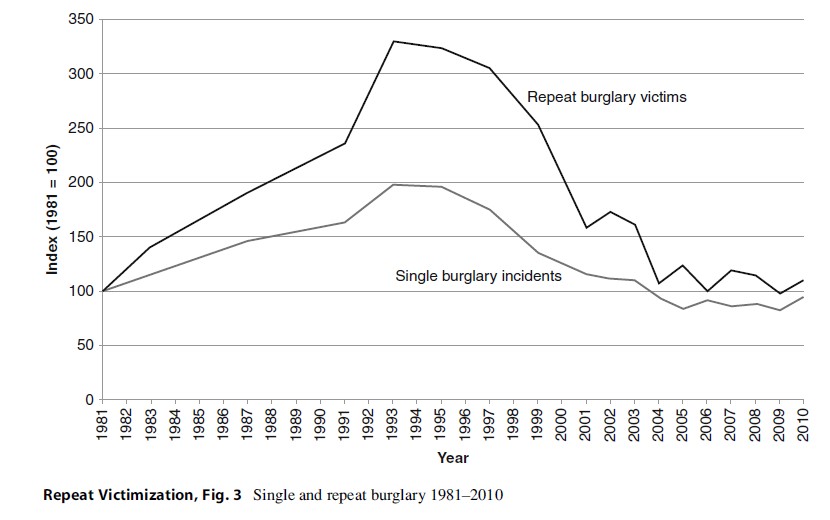
Repeated vehicle-related theft accounted for 40 % of such thefts in 1981, rising to half (49 %) by 1995. However, it accounted for less than one in three by 2010. That is, singles doubled while crimes experienced by repeat victims of car theft trebled from 1981 to 1995, after which repeats declined more rapidly than singles (Fig. 4).
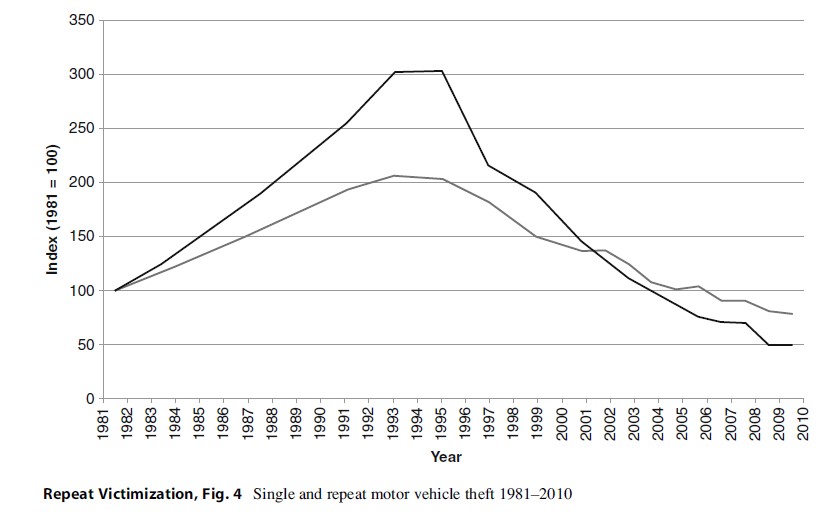
The fall in repeats from 1995 was always greater than the overall fall in any particular type of crime (Fig. 5). This does not necessarily show that declining repeats drove the crime drop, but suggests explanations should certainly consider the role of repeats. Hence, aggregate crime rates seem to go up and down in large part due to variation in repeat victimization. This is consistent with crime increasing or decreasing as the same offenders victimize the same targets more or less often. Note also that these BCS statistics are quite conservative when it comes to the role of repeats because the Britton et al. (2012) analysis, brilliant as it is, stopped counting if a victim experienced more than five similar crimes! In summary, however, most crimes are repeats or nears, and they often underlie spatial, temporal, and other variations in crime.
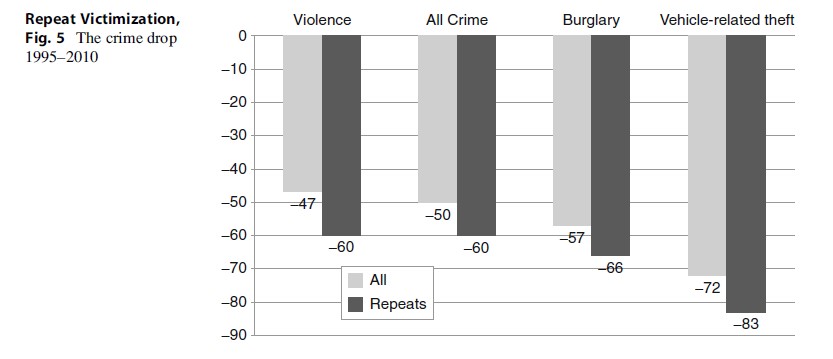
One Or 2 % Of Potential Targets Are Supertargets That Experience Around Half Of Crime
Just as wealth is hugely, perhaps grotesquely, unevenly distributed in society, so too is victimization. Most repeat victims experience two, three, or four crimes in a year, but a few experience many more. The Gini coefficient, which is often used to measure wealth inequality, has also been applied to crime, along with the visually compelling Lorenz curves (Tseloni and Pease 2005). This section outlines some explanations for the existence of such supertargets.
Since a lot of crime is not reported to the police, and reporting rates likely diminish as the number of victimizations increases, a good tactic for police is to ask victims about their recent previous experiences with crime. By this simple means, victims, or the owners or managers of properties or other places where crime clusters, can reveal patterns of repeat crimes that will not show up in traditional analysis of police records. This is a good means of gathering information about actual crime patterns that can then inform the response that is given by the police, victim services, and others. More specifically, the amount of resources spent on a response can then be tailored to the risk, with greater risk receiving proportional response. This type of model has been termed a graded response or an Olympic response with bronze, silver, and gold responses delivered, depending on risk. Police using this approach should be prepared for an increase in reported crime, as chronic victims become persuaded that such a report has become worthwhile.
There is less skepticism about the existence of supertargets when considering crime types for which high-frequency victimization is well proven. Family violence or incest provides one example, which can produce chronic repeat victims (survivors) of domestic violence, child abuse, and elder abuse. The proximity of victim and offender, perhaps living together and in the same family with emotional or economic reasons for not reporting crime, facilitates unconstrained repetition of the crime. A range of research has established that abuse can occur on a regular and frequent basis. More broadly, those with power or responsibility sometimes exploit their position to repeatedly victimize those in their care.
Crime against businesses is another area where supertargets have been identified. Some types of store represent more attractive targets than others. These include electronic goods stores, pharmacies, convenience stores, and some supermarkets. When such stores are located in high-traffic malls, their crime count rises exponentially. The same commercial establishments are the repeat targets of many shop thieves and the same returners, for example. Particular stores and commercial premises that are perceived as lucrative easy targets are frequently hit by burglars and robbers.
Disputes between neighbors or families in a neighborhood can produce high-frequency victimization. Groups or gangs may become involved in recurring targeting of the same household. A targeted household may experience many crimes of different sorts, including burglary, vandalism of property and vehicles, theft of and from vehicles, and threats and violence of various sorts against residents. Considering such contexts, the existence of chronic victims and poly-victimization by different types of crime should not be surprising.
Stalking and harassment are largely defined by their repetitive nature. Sexual victimization can also manifest itself as different types of crime (assaults, vandalism, cyber-stalking, threats) perhaps by an ex-partner or during a cohabiting or other relationship. Hate crimes, including racial attacks, homophobic crimes, and crimes against the disabled, may result in chronic victimization. A hate crime victim may be identifiable by their appearance, which could prompt victimization by different as well as the same offenders, more so if the location of the victim’s household or workplace is known. In schools, the bullying of some victims is frequent and ongoing. A victim may attract victimization from other sources if he or she acquires a reputation as a suitable target.
Some lifestyles appear related to chronic victimization. Some professions, including police, nurses, and other caring professions, are more likely to experience crime. The work can entail regular interaction with likely offenders in risky situations. One study noted that “violent series crimes that occurred in connection with a person’s job were usually committed by different offenders who were generally strangers. In contrast, violent crimes committed by spouses or acquaintances were usually perpetrated by the same person who was well known to the victim” (Dodge and Balog 1987).
Repeat offenders are more likely to experience repeat victimization (Fagan and Mazerolle 2008). This may be the result of a lifestyle which includes drug dealing, gang-related violence, ongoing disputes between rivals, or frequent interaction with criminal associates. Offenders are robbed while dealing drugs, fencing stolen goods, because they carry a stash of money and in disputes with co-offenders and rivals. Since offenders are less likely to call the police, their repeat victimization occurs with relative impunity.
A supertarget may emerge due to victimization by different offenders – a risk-heterogeneity explanation. High-frequency shoplifting at some stores falls into this category. In many instances, however, one crime boosts the likelihood of another occurring when offenders learn it is an easy and rewarding crime to commit – an event dependence explanation. The extreme case is where an offender is “dedicated” to a single target with which they frequently interact and know the likely risk and reward – as may be the situation in family violence, harassment, and stalking. The balance between the two theoretical mechanisms will vary according to the circumstances. The question then becomes why supertargets are under-researched.
Why Are Supertargets Often Overlooked?
It is probably difficult for some people to believe the extent of high-frequency victimization. Or perhaps it is just easier to overlook. Chronic victims are likely those least able to voice their complaint. The NCVS had been running for around 40 years before the Bureau of Justice Statistics began to properly acknowledge the importance of high-frequency victimization in the important study by Janet Lauritsen and colleagues (2012). And even that excellent study used the median frequency of victimization as an upper ceiling on crime counts for all victims. The British Crime Survey was similarly tardy in recognition, and having the issue drawn to the attention of the relevant Ministry excited criticism rather than recognition of the problem.
It is well documented that repeat victimization is generally understated in police data. When it comes to supertargets, this is more extreme, a conservative estimate being a twentyfold undercount (Frank et al. 2012). This is due to conditional probabilities. If the likelihood of a burglary reported to police is 50 %, then the likelihood of two at the same household being reported are 25 % (i.e., .5 × .5 =25). It follows that the likelihood that five burglaries at a household are all reported is .5×.5×.5×.5×.5 = .03125 or 3 %. This is a simplified version, but the basic argument is robust when the initial reporting likelihood and conditional likelihood of reporting of subsequent events are varied.
For crime surveys, the situation is different. If a poly-victim reports assault, burglary, robbery, car theft, and vandalism to a survey, each offence type is typically recorded as a separate, seemingly unrelated, incident or series of incidents. The British Crime Survey does not count as repeat victims those suffering repeated crime where each offense type occurs only once. Likewise, much chronic victimization will not be brought to the attention of the police, so supertargets will be less evident in recorded crime statistics.
Unfortunately, chronic victimization is sometimes swept under the carpet. It is sometimes cut from official crime because it can be “statistically awkward” to handle (Farrell and Pease 2007; Planty and Strom 2007). Crucially, when politicians use victimization surveys to set alongside police recorded crime statistics, to see whether the trends match, allowing chronic victims to be properly counted introduces a degree of sampling variability that is statistically inconvenient. In this way, statistical convenience triumphs over proper accounting of human suffering. Victim advocates may interpret this as institutional discrimination, and the impact is not trivial: If society’s resources in response to crime were apportioned according to risk, then the 2 % of supertargets would likely receive around half.
Preventing Repeat Victimization Reduces Crime When Measures Are Properly Developed And Implemented
Crime has been reduced around 20 % on average, and by greater amounts at victimized households, via targeted prevention efforts. This is the finding of a recent systematic review and meta-analysis of 31 evaluations (Grove et al. 2012; Grove and Farrell 2012). Most of the evaluations were of efforts to prevent residential burglary of which the most successful have two key characteristics:
- Measures that are locally appropriate and prevent repeats by the same modus operandi
- Measures that are thoroughly implemented
This makes crime prevention sound simple. Conceptually it is, but it is not always, easy to identify which prevention measures to introduce, to implement them, and to ensure they are used appropriately.
Ensuring that victimized households receive appropriate advice and then implement measures can be difficult. Even ensuring that police officers conduct security surveys at victimized properties has proven tricky in some instances.
The most effective measures tend to be situational. These often physically block opportunities for crime. The obvious tactics include locks and bolts in the case of burglary, but it can also include a range of other measures.
It is clear that there is plenty of scope for research into the prevention of other forms of repeat crime. Efforts to prevent repeat forms of commercial crimes, identity theft, and computer crimes, for example, appear under-developed, even though these may be areas where situational measures could be relatively easily introduced.
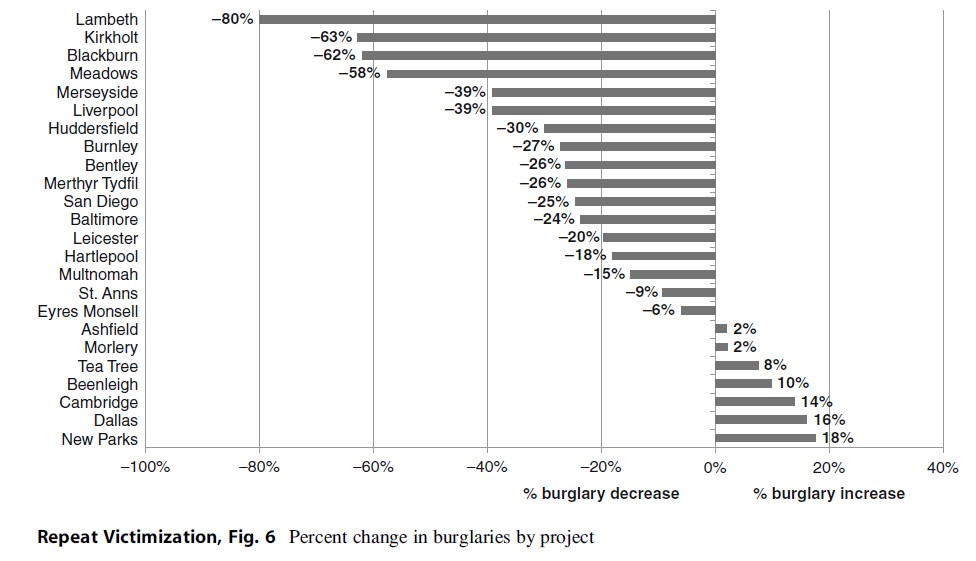
The percentage net change in burglaries for each of the 24 projects included in the systematic review is shown as Fig. 6. The percentage change in repeat burglaries is shown in Fig. 7 for the eight projects where it could be determined.
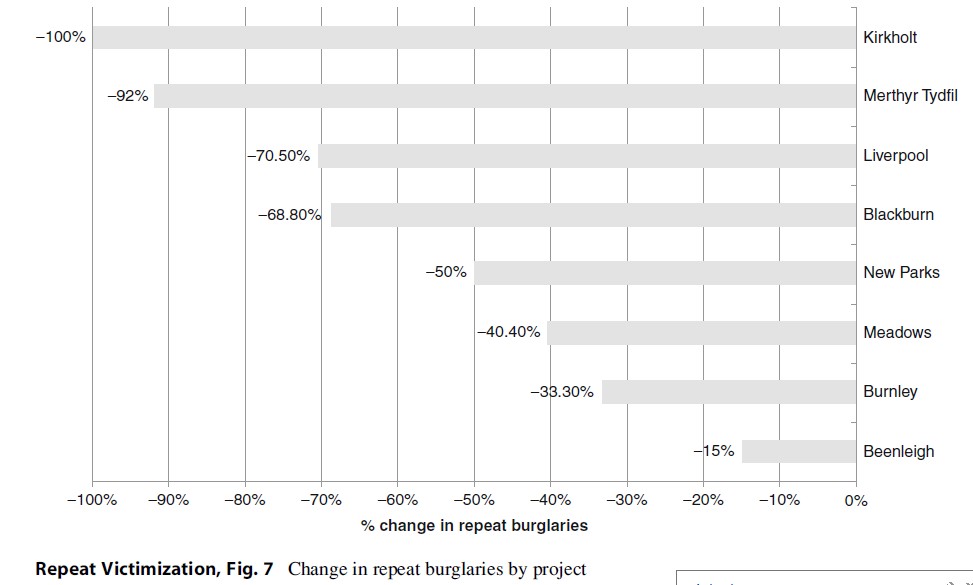
A Broader-Than-Usual Conception Of Near-Repeat Victimization, Referring To Crimes Linked By Their Similarity, May Prove A Useful Foundation For Integrating Theories Of Crime Concentration
Crimes that are linked to previous crimes but not necessarily against the same target are known as near repeats. Spatial nearness is easily conceived, so near-repeat burglaries are of households close to one already victimized, usually fairly soon afterwards. Similar patterns have been found for other crimes (Ratcliffe and Rengert 2008; Wells et al. 2008; Youtsin et al. 2011).
Here, nearness refers not only to location and timing but to other characteristics of a crime. Thefts of hot products such as a smartphones often produce near repeats defined by the identical characteristics of the product as well as the similarity of the situation and crime event. The link between repeats and near repeats is the similarity of the targets. Similarity is attractive to offenders as the task is easier when the method, risks, and rewards are known. Similarity (or difference) may occur in terms of characteristics of the target, or the time, the location, the offender, the modus operandi, or the crime type.
The dominant theory of hot-spot formation is predicated on the concepts of crime attractors and generators (Brantingham and Brantingham 1995; Kinney et al. 2008). A place with high frequency of interaction between suitable targets and likely offenders generates crime. It may be a train station, a shopping mall, an entertainment district, or another activity node with a high flow of people. That is, even if per capita crime is no higher than elsewhere, a spatial concentration of crime still results. Think of a desert versus an entertainment nightspot. However, certain places then gain a reputation as locations with many suitable targets and attract offenders as a result.
The dominant theories of repeat victimization also embody two main components. The first is uneven risk (risk heterogeneity), such that some targets flag themselves as better than others. The second is greater ensuing risk (event dependence) wherein offenders learn that a target is worth revisiting, which boosts the likelihood they return. They have colloquially become known as flag and boost theories.
The existing theory of supertargets also largely explains why hot spots contain disproportionate repeat victimization. It can be viewed as combining a generator and a boost effect. An area may have high crime because of a generator effect wherein risk heterogeneity produces crime against particular targets. Each time a target in that area is victimized, its risk of revictimization is boosted. That risk increases with each victimization, so that a few targets progress to become supertargets. Other offenders may in turn be attracted. Incorporating near repeats into this model add to its predictive accuracy.
These key concepts – flags, generators, boosters, attractors, and near-repeat difference – may provide the foundation for a unified theory of crime concentration. This, in turn, may provide new impetus and understanding for crime prevention efforts targeting clusters of crime.
Conclusion
In the four decades since frequent returners to the emergency room of a Texan hospital were observed by Johnson et al. (1973), repeat and near-repeat victimization have emerged as a cornerstone of theory and practice in the study of crime. Repeats may often underpin, and perhaps cause, aggregate crime patterns and trends. The suggestion that the major crime drops of the last two decades may be related to reductions in repeat victimization is important when considering the precise mechanisms of change.
Yet while the importance of repeats is established, the intense concentration of crime on a few supertargets is an emerging topic with tremendous potential significance. Directing resources to prevent crime against supertargets would be particularly efficient.
Evidence from a range of studies suggests that it is possible to prevent repeat victimization and that doing so reduces crime. Situational crime prevention tactics tailored to the problem and well implemented seem to work best.
Despite a growing knowledge base, there remains much unexploited potential in repeat victimization research. This should include theory and theory testing, empirical studies, and far greater prevention effort, focused on different crime types.
Bibliography:
- Averdijk M (2010) Individuals victimization patterns over time. Haveka, The Netherlands
- Brantingham PL, Brantingham PL (1995) Criminality of place: crime generators and crime attractors. Eur J Crim Policy Res 3:5–26
- Britton A, Kershaw C, Osborne S, Smith K (2012) Underlying patterns within the England and Wales crime drop. In: van Dijk J, Tseloni A, Farrell G (eds) The international crime drop: new directions in research. Palgrave, London
- Buzawa E, Hoteling GT, Byrne J (2006) Understanding the impact of prior abuse and prior victimization on the decision to forego criminal justice assistance in domestic violence incidents: a life-course perspective. Brief Treat Crisis Interv 7(1):55–76
- Daigle LE (2010) Risk heterogeneity and recurrent violent victimization: the role of DRD4. Biodemography Soc Biol 56:137–149
- Daigle LE, Fisher BS, Cullen FT (2008) The violent and sexual victimization of college women: is repeat victimization a problem? J Interpers Violence 23(9):1296–1313
- Davis RC, Taylor BG, Titus RM (1997) Victims as agents: implications for victim services and crime prevention. In: Davis RC, Lurigio AJ, Skogan WG (eds) Victims of crime, 2nd edn. Sage, Thousand Oaks
- Dodge RW, Balog FD (1987) Series crimes: report of a field test. Bureau of Justice Statistics, Washington, DC
- Fagan AA, Mazerolle P (2008) Repeat offending and repeat victimization: assessing similarities and differences in psychosocial risk factors. Crime Delinq 57(5):732–755
- Farrell G (1995) Progress and prospects in the prevention of repeat victimisation. In Tilley N, (ed) The Handbook of Crime Prevention and Community Safety. Cullompton, Devon: Willan Publishing, pp 145–172
- Farrell G, Pease K (2007) The sting in the British crime survey tail: multiple victimizations. In: Maxfield M, Hough M (eds) Surveying crime in the twenty first century, vol 22, Crime prevention studies. Willan, Cullompton, pp 33–54
- Frank R, Brantingham PL, Farrell G (2012) Estimating the true rate of repeat victimization from police recorded crime data: a study of burglary in Metro Vancouver. Can J Criminol Crim Justice 54(4):481–494
- Gabor T, Mata F (2004) Victimization and repeat victimization over the life-span: a predictive study and implications for policy. Int Rev Victimol 10:193–221
- Grove LE, Farrell G (2011) Repeat victimization. Oxford Bibliographies Online (Criminology). Oxford University Press, New York
- Grove LE, Farrell G (2012) Once bitten, twice shy: preventing repeat victimization. In: Welsh BC, Farrington DP (eds) Oxford handbook of crime prevention. Oxford University Press, New York
- Grove L, Farrell G, Farrington DP, Johnson SD (2012) Preventing repeat victimization: a systematic review. Swedish National Council for Crime Prevention, Stockholm. www.bra.se
- Johnson JH, Kerper HB, Hayes DD, Killenger GG (1973) The recidivist victim: a descriptive study. Criminal justice monograph, vol IV, no 1. Institute of Contemporary Corrections and the Behavioral Sciences, Sam Houston State University, Huntsville
- Kinney JB, Brantingham PL, Wuschke K, Kirk MG, Brantingha PJ (2008) Crime attractors, generators and detractors: land use and urban crime opportunities. Built Environ 34(1):62–74
- Lauritsen J, Gatewood Owens J, Planty M, Rand MR, Truman JL (2012) Methods for counting high frequency repeat victimizations in the national crime victimization survey. Bureau of Justice Statistics, Washington, DC
- Mele M (2009) The time course of repeat intimate partner violence. J Fam Violence 24:619–624
- Morgan F (2001) Repeat burglary in a Perth suburb: indictor of short-term or long-term risk? In: Farrell G, Pease K (eds) Repeat victimization. Criminal Justice Press, Monsey, pp 83–118
- Nazaretian Z, Merolla DM (2013) Questioning Canadian criminal incidence rates: a re-analysis of the 2004 Canadian victimization survey. Can J Criminol Crim Justice, pp 1–23. DOI:10.3138/cjccj.2012.E18
- Pease K (1998) Repeat victimisation: taking stock, Crime detection and prevention series paper 90. Home Office, London
- Perreault S, Suave´ J, Burns M (2010) Multiple victimization in Canada, 2004. Statistics Canada, Ottawa
- Planty M, Strom KJ (2007) Understanding the role of repeat victims in the production of annual victimization rates. J Quant Criminol 23(3):179–200
- Ratcliffe JH, Rengert GF (2008) Near repeat patterns in Philadelphia shootings. Secur J 21:58–76
- Sidebottom A (forthcoming) Repeat burglary victimization in Malawi and the influence of housing type and arealevel affluence. Secur J 1–17. doi: 10.1057/sj.2011.22
- Tseloni A, Pease K (2005) Population inequality: the case of repeat victimization. Int Rev Victimol 12:75–90
- Wartell J (2010) Environmental criminology: translating theory into practice. In: Presentation to the international symposium on environmental criminology and crime analysis, Brisbane, Australia, July
- Wartell J, Gallagher K (2012) Translating environmental criminology theory into crime analysis practice. Policing: J Policy Pract. doi:10.1093/police/pas020
- Wells W, Wu L, Ye X (2008) Patterns of near-repeat gun assaults in Houston. J Res Crime Delinq 49(2): 186–212
- Youtsin TJ, Nobles MR, Ward JT, Cook CL (2011) Assessing the generalizability of the near repeat phenomenon. Crim Justice Behav 38(10): 1042–1063
See also:
Free research papers are not written to satisfy your specific instructions. You can use our professional writing services to buy a custom research paper on any topic and get your high quality paper at affordable price.





